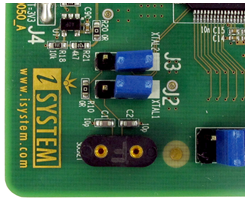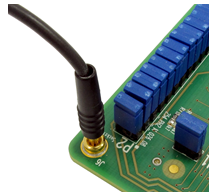Configuration
J1: Target reset configuration
Jumper J1 connects the TC265DE reset line (PORST) and the target reset line. By default J1 is populated.
When having problems establishing the initial debug session with the emulation adapter, try to remove J1 and see if it makes any difference.
J2 and J3: Clock source configuration
Jumpers J2 and J3 select clock source for the microcontroller on the emulation adapter.
Per default, both jumpers are set to position 1-2, which yields the clock source being used from the target.
|
Note that the emulation adapter may not operate when crystal circuit is used in the target. Typical design guideline is that the crystal should be as close as possible to the microcontroller. However, it may happen that the target crystal may not oscillate in conjunction with the emulation adapter since clock lines (XTAL1, XTAL2) between the target and the emulation device on the emulation adapter can become too long, consequentially affecting the impedance of the crystal circuit too much. There should be no problem if the oscillator is used in the target. |
If an oscillator in the target is not an option and the target crystal doesn’t oscillate in conjunction with the emulation adapter, clock from the emulation adapter must be used (J2 & J3 position 2-3). In this case, a crystal circuit must be assembled on the emulation adapter. Below Crystal socket. Crystal circuit is located in the corner of the emulation adapter, next to the connector P1.

Per default 10pF capacitors are populated for C1 and C2 and the crystal Q3 is not populated. Note that C1 and C2 values are valid for 20MHz crystal only. If different crystal is used, the default 10 pF capacitors must be replaced with proper value.
|
J5 & J6: GND connecting points
J5 and J6 provide grounding points on the Emulation Adapter.
In case a good ground connection is required, connection points bridge J5 and pin J6 provide easy access to the emulation adapter GND potential. |
Startup and Power Supply Mode
The target device TC265 being emulated with this emulation adapter, can have the external nominal system supply either 3.3V or 5V. Both are supported by the emulation adapter. The power supply scheme of the TC265DE at startup is based on the latched status of HWCFG[0:2] pins before PORST release. With the emulation adapter, HWCFG[0:2, 6] pins are left unconnected (floating) while the TC265DE PORST signal is low. This ensures embedded voltage regulators EVR33 and EVR13 are active by default. As soon as the PORST line is released from the low state, the HWCFG[0:2, 6] pins get connected to the target via the emulation adapter logic.
P2: Power supply configuration
Emulation Adapter Power supply is configured via the unshrouded 26-pin 2.54 mm header (P2).
Signal Direction |
Signal |
Pin |
Pin |
Signal |
Signal Direction |
|---|---|---|---|---|---|
Target board |
NC |
1 |
2 |
NC |
Emulation device |
Target board |
VEXT |
3 |
4 |
CVEXT |
Emulation device |
Target board |
VDDM |
5 |
6 |
CVDDM |
Emulation device |
Target board |
VFLEX |
7 |
8 |
CVFLEX |
Emulation device |
|
NC |
9 |
10 |
NC |
|
|
NC |
11 |
12 |
NC |
|
|
NC |
13 |
14 |
NC |
|
|
NC |
15 |
16 |
NC |
|
|
NC |
17 |
18 |
NC |
|
|
NC |
19 |
20 |
NC |
|
|
GND |
21 |
22 |
GND |
|
|
GND |
23 |
24 |
GND |
|
|
GND |
25 |
26 |
KEY |
|
P2 Signal description
NC – Not Connected
Refer to the microcontroller user’s manual for more details which power supply designation in the above table belongs to which power supply.
By default all jumpers are set and connect target power supply coming from the target to the microcontroller residing on the emulation adapter. In principle, pins 3-4, 5-6, 7-8, must be bridged only but for the convenience and ease of use all jumpers are set, except for pins 25-26. Pin 26 is the polarizer key preventing incorrect connection of the IEA-PS power supply, when connected.


